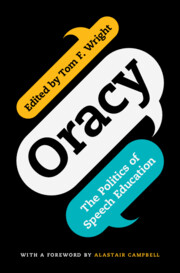Refine search
Actions for selected content:
285 results
Chapter 8 - ‘How to cultivate a love for reading’
- from Part II - Readers and Audiences
-
-
- Book:
- African Literature in Transition
- Published online:
- 23 October 2025
- Print publication:
- 06 November 2025, pp 166-183
-
- Chapter
- Export citation
Chapter 6 - Still Images, Moving Images
- from Part I - Producing Print
-
-
- Book:
- African Literature in Transition
- Published online:
- 23 October 2025
- Print publication:
- 06 November 2025, pp 129-146
-
- Chapter
- Export citation
7 - Latin in the Early History of English
- from Part II - Contact and External Influences
-
-
- Book:
- The New Cambridge History of the English Language
- Published online:
- 30 October 2025
- Print publication:
- 30 October 2025, pp 193-218
-
- Chapter
- Export citation
19 - Historical Sociolinguistics
- from Part III - The Long View by Levels and Areas
-
-
- Book:
- The New Cambridge History of the English Language
- Published online:
- 30 October 2025
- Print publication:
- 30 October 2025, pp 720-790
-
- Chapter
- Export citation
24 - Ego Documents in the History of English
- from Part III - Genre and Medium in the Record
-
-
- Book:
- The New Cambridge History of the English Language
- Published online:
- 18 October 2025
- Print publication:
- 16 October 2025, pp 586-612
-
- Chapter
- Export citation
21 - Medical and Scientific Writing
- from Part III - Genre and Medium in the Record
-
-
- Book:
- The New Cambridge History of the English Language
- Published online:
- 18 October 2025
- Print publication:
- 16 October 2025, pp 506-533
-
- Chapter
- Export citation
4 - Food as a Social Relation: Sabzi and the Question of Household Skilled Labor
-
- Book:
- Tied Up in Tehran
- Published online:
- 28 September 2025
- Print publication:
- 16 October 2025, pp 57-91
-
- Chapter
- Export citation
2 - Vernacular Speech in Writing
- from Part I - The Textual Record
-
-
- Book:
- The New Cambridge History of the English Language
- Published online:
- 18 October 2025
- Print publication:
- 16 October 2025, pp 50-74
-
- Chapter
- Export citation
1 - The Historiographical Context
- from Part I - The Selbstzeugnisse in Context
-
- Book:
- Making Merchants
- Published online:
- 19 September 2025
- Print publication:
- 09 October 2025, pp 9-17
-
- Chapter
- Export citation
20 - Liturgical Texts
- from Part V - The Study of Liturgy
-
-
- Book:
- The Cambridge Companion to Christian Liturgy
- Published online:
- 19 September 2025
- Print publication:
- 09 October 2025, pp 355-368
-
- Chapter
- Export citation
African and Asian Writings from Mozambique: Uncovering Indigenous Records in a Portuguese Colonial Archive
-
- Journal:
- History in Africa , First View
- Published online by Cambridge University Press:
- 09 October 2025, pp. 1-28
-
- Article
-
- You have access
- Open access
- HTML
- Export citation
Chapter 8 - Meaning-making with children: Semiotics, learning and communicating
-
-
- Book:
- The Arts and Meaning-Making with Children
- Published online:
- 11 September 2025
- Print publication:
- 25 September 2025, pp 163-187
-
- Chapter
- Export citation

Oracy
- The Politics of Speech Education
-
- Published online:
- 23 September 2025
- Print publication:
- 31 July 2025
Chapter 14 - Using picture books to develop language and literacies in HASS
- from Part III - Teaching and learning in HASS
-
-
- Book:
- Making Humanities and Social Sciences Come Alive
- Published online:
- 02 August 2025
- Print publication:
- 14 August 2025, pp 236-250
-
- Chapter
- Export citation
Chapter 6 - Elementary School Adjustment
-
- Book:
- School Adjustment
- Published online:
- 29 August 2025
- Print publication:
- 07 August 2025, pp 132-187
-
- Chapter
- Export citation
Chapter 2 - Why the Arts are fundamental
- from Part 1 - Why: the arts in education and society
-
- Book:
- Teaching the Arts
- Published online:
- 28 July 2025
- Print publication:
- 06 August 2025, pp 31-63
-
- Chapter
- Export citation
20 - Literacies for Teaching
- from Part V - Practice
-
-
- Book:
- The Cambridge Handbook of Technology in Language Teaching and Learning
- Published online:
- 15 June 2025
- Print publication:
- 26 June 2025, pp 332-347
-
- Chapter
- Export citation
Chapter 11 - Developing writing
- from Part 2 - Developing language and literacy
-
-
- Book:
- Language and Literacy
- Published online:
- 29 May 2025
- Print publication:
- 12 June 2025, pp 240-261
-
- Chapter
- Export citation
Chapter 9 - Developing oracy
- from Part 2 - Developing language and literacy
-
-
- Book:
- Language and Literacy
- Published online:
- 29 May 2025
- Print publication:
- 12 June 2025, pp 197-218
-
- Chapter
- Export citation
Chapter 3 - Morphological awareness
- from Part 1 - Language and literacy fundamentals
-
-
- Book:
- Language and Literacy
- Published online:
- 29 May 2025
- Print publication:
- 12 June 2025, pp 51-70
-
- Chapter
- Export citation
